You can water a garden very well without a hosepipe. Practice now and you’ll be well prepared for a hosepipe ban.
I wince at seeing the way many gardeners overuse their hosepipes. Sprinklers spray a wasteful curve and even spray guns encourage overuse of our precious water resources. You can water a garden very well with a can and it needn’t take much longer than with a hosepipe. This blog will explain why.
I have had to develop good techniques to water my garden and conserve water over a number of years. I am pleased to do so for environmental reasons but it is also necessary because I have a large garden. At 2 acres there is no way I can water everywhere. I am sure I use less water now than when I had a small courtyard garden. Back then I sprayed water around with insouciance, now I’m much more careful.
Here I describe how to water a garden wisely – to save you time, to save water and to ensure your plants thrive.
Having a beautiful, lush garden is a joy, but keeping all those thirsty plants hydrated can be tricky, especially if you don’t have access to running water. However, with some creativity and strategic planning, you can absolutely grow a thriving garden without taps or hoses!
In this comprehensive guide, we’ll walk through the top techniques for irrigating your garden manually, discuss the best watering practices, and explore alternative water sources to quench your garden’s thirst.
Gather Your Watering Tools
First things first – assemble your arsenal of watering cans, buckets, and other vessels. These will be your trusty companions as you hand-water your garden beds and containers.
-
Watering cans – A classic way to water small gardens and potted plants. Opt for ones with long spouts to easily reach plants’ bases. Metal cans are durable; plastic is lighter. Have a few medium and large sizes.
-
Milk jugs – Recycle plastic gallon jugs by poking drainage holes in the bottom. Bury them by plants to slowly dispense water underground.
-
Rain barrels – Position barrels under gutter downspouts to collect roof runoff. Use watering cans to distribute.
-
Spray bottles – Mist delicate seedlings and transplants using recycled spray bottles.
-
Kitchen pots and buckets – Anything that holds water can help transport it from source to garden. Dedicate a set for garden use.
Water Wisely
When hand-watering, aim for deep weekly soakings rather than frequent shallow sprinkles. Deep watering encourages plants to develop extensive root systems, making them more drought tolerant.
The best times to water are early morning or evening when evaporation rates are lower Avoid midday watering. Check soil moisture before watering – if it’s dry 2-3 inches down, it’s time to irrigate.
Group plants with similar watering needs together for efficiency. For example tomatoes need consistent moisture, while berries prefer drier conditions. Arrange accordingly.
Explore Alternative Water Sources
Running faucets aren’t your only options for sourcing water Consider these creative tactics
-
Rainwater harvesting – Direct downspouts into rain barrels for free garden water. Add screens to keep out debris.
-
Air conditioning condensation – Collect the water dripping from window A/C units or dehumidifiers in buckets or pans.
-
“Gray water” recycling – Reuse unsoiled wash water from sinks, showers, tubs on ornamentals and trees. Don’t apply to edibles.
-
Community water sources – Some public parks or buildings may allow limited water collection. Always ask permission first.
-
Frugal indoor use – When cooking, save unused water from boiling vegetables, pasta, etc. Let cool before using in the garden.
-
The “two-bucket method” – Place one bucket in the shower as it warms up. Transfer water to the second bucket, then to the garden.
Low-Tech Irrigation Methods
Distributing water efficiently is key for success without running taps. Here are some excellent off-grid watering techniques:
-
Ollas – Unglazed terra cotta vessels seep water into soil. Bury near plants and fill manually as needed.
-
Plastic bottle drippers – Poke tiny drainage holes in bottle caps. Push into soil upside-down to slowly diffuse water underground.
-
Soaker hoses – These porous hoses seep moisture along entire lengths. Connect to rain barrel for targeted irrigation.
-
Wicking beds – Lining beds with absorbent cloth draws water via capillary action from a reservoir.
-
Watering spikes – Fit shrub or tree tubes with hollow spikes. Fill tubes manually for slow, direct watering.
Bonus Tips for Water-Wise Gardening
-
Mulch beds to reduce evaporation and block weeds. Organic materials like bark chips, grass clippings and straw work great. Replenish yearly.
-
Add compost to improve soil’s ability to retain moisture. Aim for 1-3 inches twice annually.
-
Collect water from rinsing produce for immediate garden use.
-
Group thirsty plants like tomatoes close to your water source for efficiency.
-
Time plantings so fewer crops require irrigation at once.
-
Check for leaks and promptly fix drips or sprinkler malfunctions.
-
Consider rain collection systems like sheds, tarps, and gravity-fed gutter barrels to harvest natural precipitation.
Finally, choose drought-tolerant varieties suitable for dry gardening. Native plants are excellent choices. With smart preparation and practices, you can successfully grow an abundant garden oasis minus running water!
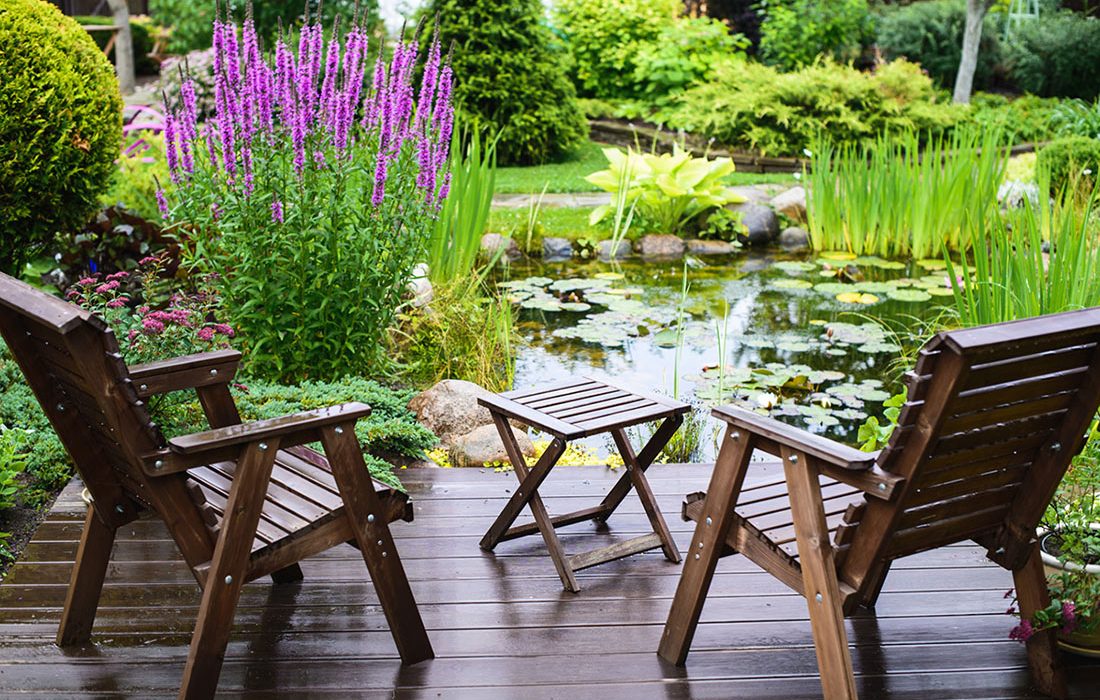
Some good techniques to save water in the garden.
- When you plant a shrub or tree place a plastic pipe deep into the soil beside it. When it needs watering you use a watering can to pour water into the pipe, directly at the roots. Watering at the surface, a proportion will always evaporate away and be wasted.
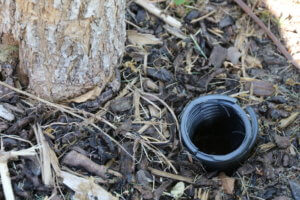
- In hot weather place a tray under seedlings or a dish under container plants. This seems simple but I’ve observed what a big difference this can make in hot weather. The tray will catch water running through your seed trays and provide a little reservoir for the plant to use between watering. Some plants do hate sitting in water but there aren’t many and in hot weather the water in the reservoir will be used quickly.
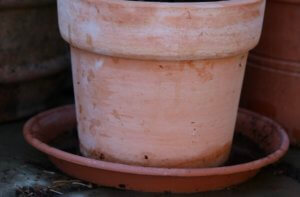
- Do not water during the heat of the day as you will waste allot of water to evaporation. Also many plants have techniques to save water by reducing their transpiration rate. Many droop their leaves in the heat of the day only to pop back up in the evening without additional water. Don’t panic yourself into watering.
- Avoid porous pots for container gardens. Terracotta is very attractive but in hot weather, moisture is lost through the clay of the pot. Good quality plastic containers can last a lifetime and some of the more expensive brands look like terracotta from a distance. Cheap plastic should be avoided as it will become brittle over time. Glazed pots are very pretty and can be expensive but will reduce water lost through the sides of the pot. If you want to persevere with terracotta, choose plants that or more drought resistant, stand them in a dish, line the terracotta with plastic sheet cut from old compost bags, or stand a plastic pot within the terracotta.
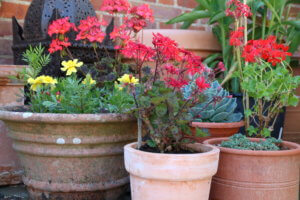
- Use a plastic bottle as a reservoir next to thirstier plants. Some people cut the bottle in half so it can be filled easily. Others keep the bottle intact, burn holes in the lid with a hot needle then plunge the bottle upside down into the soil. The water will slowly dissipate into the soil, encouraged when heat expands the trapped air at the top.
- I don’t bother with water retaining crystals. These are granules which can be mixed into your compost where they swell on watering to store extra water. I find this an unnecessary and more costly step in my planting process. I haven’t observed much difference in how long I can go between waterings.
- Collect water in water butts throughout the winter and use so-called grey water from your washing up or baths. Even a couple of watering cans from a bath used to water pots will make a huge difference to your water use over a long hot summer. Do not use water from a butt on small seedlings as this can contain fungal diseases that will affect your seedlings and causing damping off.
- Mulch you borders in early spring to retain moisture in the soil. I use compost from my compost bins for this although I often have to buy in bulk bag orders from local suppliers as I can rarely produce enough for all my borders. In a really long dry summer you will need to start watering some plants but I’ve noticed how moist the soil is under the mulch compared to unmulched beds. Plus – the mulch provides some nutrients and definitely improves soil structure over time.
5 good reasons why it’s OK to ditch the hosepipe
Whilst most people see the use of a hosepipe to water a garden as labour saving, I genuinely think in most circumstances it isn’t. Here’s why.
- Weeds need water too. If you direct a flow from a watering can at the roots of a wanted plant it will thrive whilst the weeds around it wither and die. Spread a sprinkler in a wide curve over a large area and up will pop the weeds. A few minutes extra watering with a can will save many more of hot dusty weeding. It’s a rational decision.
- Plants do better with a deeper root run. Deep roots are encouraged through parsimonious watering. Give each plant a good drink when you first plant it, then only give it the minimum water it requires to stay alive. This will encourage its roots to travel down in search of moisture. Pamper a plant with regular shallow waterings in the early days and you will encourage the roots to stay at the surface – a problem in the long term.
- Not all plants need regular watering. Wandering around the garden with a hose it is tempting to throw some water on everything whether it needs it or not. It is far better to observe your plants and act when they are showing signs of wilt so you do not waste water on plants that just don’t need it. You will learn over time which plants need water more frequently and which will see out a drought quite happily with barely a drop. You can then target your watering effectively, knowing which need watering daily, which weekly and which never.
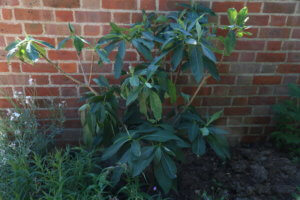
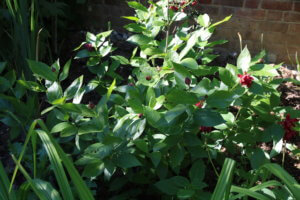
- Hoses stop you investing in water saving devices and techniques. If you’ve got a hosepipe you are less likely to invest in water saving devices, to store water in butts and tanks or to make good decisions on plant choices. A few small cost effective strategies when planting will save you time watering in the long term. See below for some water-saving ideas.
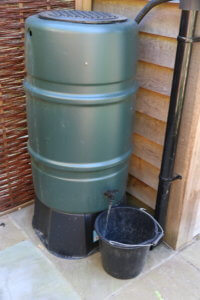
- Finally, come the hosepipe ban you’ll not know how to cope. You will be cursing the weather or the water company rather than enjoying a garden that can thrive regardless.
Easiest Way to Water Container Garden Without Drip Irrigation or a Hose Bib
FAQ
How do you water plants without running water?
Use a plastic bottle as a reservoir next to thirstier plants. Some people cut the bottle in half so it can be filled easily. Others keep the bottle intact, burn holes in the lid with a hot needle then plunge the bottle upside down into the soil.
How do you make a self-watering device for plants?
rope and cut off a piece, then grab a screw and tie a knot around it… The next thing you wanna do is grab a container or a vase and fill it up with water… Then drop the screw in the water. Grab a plant, tie the other end of the rope, rope to a stick, then . just pop the stick into the sole of your plants…
How do I keep my garden watered while away?
Fill a plastic bottle with water, make a few small holes in the cap, and bury it upside down in the soil. The water will slowly drip out and keep the soil moist. Apply a layer of mulch around your plants to help retain moisture in the soil. This can reduce the frequency of watering needed.
How do you water a garden without a tap?
One of the simplest ways to water your garden without an outside tap is by using a watering can. This method is ideal for small gardens and container plants. You can fill up the watering can from a nearby indoor tap or rainwater harvesting system. Make sure to water your plants thoroughly, but avoid overwatering them.
How do I collect rainwater for my Garden?
One of the simplest and best things you can do for your garden is to collect rainwater. This is a topic in and of itself, but the basics are just that: hang gutters and collect the water in some type of vessel. For us, we started with just collecting water in one 55-gallon and one 30-gallon drum because it was what we had.
How do you water a garden without a spray nozzle?
Using a plain garden hose (with or without a spray nozzle) is a classic way to water your garden. Some nozzle attachments have multiple settings, including: Soaker – this setting allows you to water without using a strong spray of water (so you can avoid washing away dirt and exposing the roots of plants).
How do you use a watering can?
One simple method is using a watering can, ideal for small gardens and container plants. Fill it from an indoor tap or a rainwater harvesting system. Alternatively, consider a hose attachment that connects to your kitchen or bathroom faucet, designed for standard faucets and easy attachment.
How to collect and reuse water to water your garden?
You can collect and reuse water from various sources to water your garden. For example, you can collect rainwater in a barrel or bucket and use it to water your plants. You can also collect water from activities like washing your hands or doing the dishes and use it to water your garden.
How do I Keep my plants from evaporating too quickly?
This will help prevent water from evaporating too quickly and ensure that your plants get the most out of each watering session. Avoid watering during the middle of the day when the sun is at its strongest, as this can cause water to evaporate before it reaches the roots of your plants.
